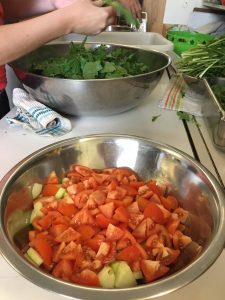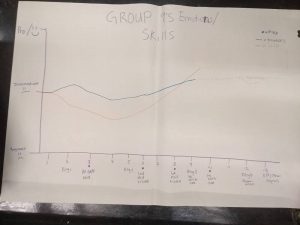“It’s the best food in town!” – GNH Stakeholder


Figures 1 & 2: Foods from GNH lunches
THIS WEEK’S OBJECTIVES
| Objectives | Dates |
| Distribute the work for the final report and presentation | November 13 |
| Last group (we split into 3 groups) visits GNH lunch | November 6 |
| Finish conducting quantitative observations by using EaTracker and making nutritional reports | November 15 |
| Finalize and complete a copy of nutritional assessments and a handout outlining common nutritional deficiencies for seniors and recommendations of common foods addressing these deficiencies that can be given to Katelyn (GNH representative) | November 17 |
Achievements:
- Two of the three groups visited GNH lunches
- Collected qualitative data
- Took photos and briefly interviewed the stakeholders
- Split recipes among the six of us and began talking about EaTracker
A Moment of Significant Change For Group 9
Figure 3: Changes in Emotions and Skills Graph for Group 9
What:
This week during our tutorial session we did a Moment of Significant Change Workshop. The workshop allowed us to track our changes in emotions and skills over the past few weeks and what we thought our future emotions and skills would be. In figure 3, you will see that we were most happy and thought our skills were most developed when we personally visited the Gordon Neighbourhood House (GNH). These visits allowed us to connect with the stakeholders, have insight into what they thought about the lunch program at GNH, and opened a new perception of the individuals who visited GNH lunches. There were also small dips between the weeks when we had felt lost within our project or when we had some doubts about our vision. In the future weeks to come, we believe that our emotions and skills would improve. We will gain more insight as we begin to analyze GNH’s lunch menus and come up with future menu improvements.
So What:
It’s normal to undergo dips in our emotions during the course of a project; these are times when we grow the most. For example, after writing our proposal and receiving feedback from our Teaching Assistant and community partner, we felt our emotions begin to deplete because we thought we had a good grasp of what was going on and wished we could have done better in hindsight. However, this was a moment of growth as it meant we had more to learn about our project and the community we are working with. This process allowed us to narrow our knowledge gap as we had an opportunity to do some research, reflect, and revise our proposal. We felt that we had strengthened our communication and writing skills from this process.
Visiting GNH made us feel significant because we were able to contribute to the community by taking time talking with the stakeholders and listening to their wealth of knowledge. During our visits, we noticed that a vast majority of guests at GNH were pleased with the food offered and were glad that everything used to make the dishes were either grown at GNH or locally sourced. Some of the guests knew about the individual benefits local foods offer, such as fresher and more nutritious foods, but they were unsure as to why or how local foods can contribute to a healthier community and planet. This allowed us to be able to connect with the guests and share the knowledge we learned from class. We informed them that local foods are capable of reducing greenhouse gas emissions due to the transportation of foods, supported small-scale, sustainable farmers, and contribute to community economic development (Gibb & Wittman, 2013). By sharing what we have learned in class and listening to the stories the guests had to offer, we were able to solidify the knowledge we have learned and also gain different perspectives from the stakeholders. This also helped us build relationships with the stakeholders at GNH.
Other than expanding our knowledge, another significant change that occurred was our perception of the stakeholders. When we started our project you could say we had a very narrow-minded, privileged view of the guests we thought would visit GNH (Yankini, 2014). At first, we believed that all the guests would appear to be low-income but we were wrong. Many of the guests were dressed quite fancy and treated the lunches as a social gathering. They were much more positive and enthusiastic than we expected. We realized that many of the guests seemed to be there more for social connections rather than the food. You could say we were pretty embarrassed by our misconception and that we should have done more research before jumping to conclusions.
Now What:
Now that we have personally visited GNH and have gotten to properly observe the lunches, we hope to increase our skills and continue an upward trend in emotions as well. Since we are nearing the end of our project, we hope to use the experiences and knowledge we gained from GNH lunches to better our project and maybe revise our thoughts on the guests at GNH. We will still be doing a nutritional assessment on the recipes at GNH using recommendations for seniors. However, we may have to remove the low-income assumption we made at the start of our project. We will also do our best to take into consideration the feedback we have collected from the stakeholders and incorporate the feedback into the suggestions within our nutritional assessment. Lastly, we hope that what we have learned from this workshop can further carry us towards a smooth and successful final project.


Figures 4 & 5: Tables set for lunches at GNH ft. Amanda
Graceful Dismount (Strategy for successful completion):
- Distribute tasks fairly and equally amongst each group member
- Meet deadlines and do not leave things last minute
- If we have any questions, we will ask the TA and community partner ASAP and not leave it until last minute
- Designate a specific editor to edit all the final products
References:
Gibb, N., & Wittman, H. (2013). Parallel alternatives: Chinese-canadian farmers and the metro
vancouver local food movement. Local Environment, 18(1), 1.
Yankini, M. (2014, June). Malik Yankini: Food, Race and Justice.[Video File]. Retrieved from:
https://www.youtube.com/watch?v=miukaKDL-Cs
